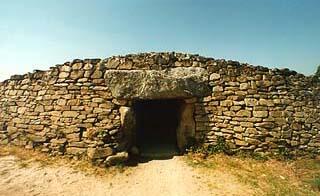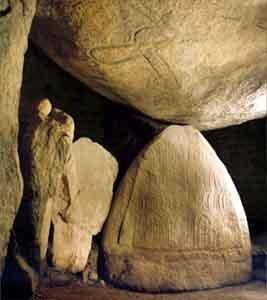- Home
- Megalithism in Morbihan
- Locmariaquer
- Table-des-Marchands (Merchant's table)
- The peninsula and its monuments
- A cradle of archeological research
- Before the megaliths
- Grand-Menhir (Great Menhir)
- Er-Grah Tumulus
- La Table-des-Marchands (Merchants’s table)
- From Mané-Lud to Mané-er-Hroeg
- Pierres-plates (Flat Stones), a late tomb
- Megalithic art in Locmariaquer
- Locmariaquer, from Antiquity to the Middle Ages
The entrance of the restored cairn of the Table-des-Marchands: initially, it might have been 4 to 6m high, as at Gavrinis.
Inside the chamber during excavation : the entirely visible sandstone shield-stele carries the huge orthogneiss slab whose inner face is decorated.
The first excavation of this emblematic monument was carried out in 1811.
Though methods were still rudimentary at that time, it was noticed that the in-fill used in the chamber was stratified and different items were found, including a "golden thread" (probably a chalcolithic jewel) which unfortunately fell victim to the greed of those who made the discovery.
A dolmen to honour a stele
Typologically, the Table-des-Marchands dolmen is a classic passage grave, with a "semi-megalithic" structure (big spaces between the slabs of the walls filled in with drystone walling).
The passage is 7 m long and only 1.4 m high at the entrance but its height quickly increases.
The polygonal chamber is almost 2.5 m high. The remarkable height was probably determined by that of the chevet jambstone, a beautiful white sandstone slab originating at least 10 km away.
Its natural ogival shape is emphasised by a particularly elaborate "shield" decoration.
Excavations directed by J. L'Helgouac'h proved that the stone was set in place before the dolmen itself was built. In all likelihood, an open air stele (probably related to the Grand-Menhir alignment) was strategically placed and the passage grave built around it.

